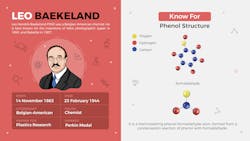Leo Baekeland’s Aldehydes and the Toxic Smell of New Automobiles
Key Takeaways
- Bakelite Revolution: Leo Baekeland's invention of Bakelite in 1907, the first synthetic plastic, sparked widespread use in the automobile industry, with Rolls-Royce using it in gear levers and ignition coils.
- EV Plastic Innovation: New plastic technologies, like Solvay’s Xencor Xtreme and SABIC’s STAMAX, are designed to withstand high temperatures, improving electric vehicle safety in thermal runaway situations.
- Toxic "New Car Smell": Recent studies highlight the health risks posed by volatile organic compounds (VOCs), including formaldehyde, emitted by new car interiors, particularly under high heat conditions.
EVs and Plastics
Aromatic Toxic Interiors
More on Baekeland’s Work
About the Author
Seán Ottewell
Editor-at-Large
Seán Crevan Ottewell is Chemical Processing's Editor-at-Large. Seán earned his bachelor's of science degree in biochemistry at the University of Warwick and his master's in radiation biochemistry at the University of London. He served as Science Officer with the UK Department of Environment’s Chernobyl Monitoring Unit’s Food Science Radiation Unit, London. His editorial background includes assistant editor, news editor and then editor of The Chemical Engineer, the Institution of Chemical Engineers’ twice monthly technical journal. Prior to joining Chemical Processing in 2012 he was editor of European Chemical Engineer, European Process Engineer, International Power Engineer, and European Laboratory Scientist, with Setform Limited, London.
He is based in East Mayo, Republic of Ireland, where he and his wife Suzi (a maths, biology and chemistry teacher) host guests from all over the world at their holiday cottage in East Mayo.

